
Cat. No.
OWNER???S MANUAL
Please read before using this equipment.
MODEL 130 MOVIECORDER???
Camcorder

Cat. No.
OWNER???S MANUAL
Please read before using this equipment.
MODEL 130 MOVIECORDER???
Camcorder

FEATURES
Your Optimus Model 130 MovieCorder cam- corder combines all the features of a video camera and a portable VCR in one lightweight package. Using standard VHS cassettes, you can record and play back home movies any- where. The
You can also use the camcorder as a VCR to play back a tape or copy to a VCR.
This camcorder has many special features that make operation simple, convenient, and versatile. Be sure to read this manual carefully and completely so you can understand and enjoy all of your camcorder???s features.
The camcorder has these features.
CCD Imager ??? provides a clear,
Electronic Viewfinder with Adjustable Fo-
cus ??? lets you monitor the picture during re- cording and playback.
Digital Zoom Enhancement ??? increases the magnification of the power zoom up to 2 times (to
Fuzzy Logic Circuitry ??? enables the cam- corder to focus and adjust to different lighting conditions, much like the human eye.
Automatic Focusing ??? provides automatic,
Zoom Automatic Focusing ??? automatically
Power Sources ??? Operate this product usin g only the power source indicated on its marking label. If you are not sure of your home's power type, consult your product dealer or local power company.
Polarization ??? This product is equipped with a polarized AC line plug (a plug having one blade wider than the other). This plug will fit in the power outlet only one way. This is a safety feature. If you cannot insert the plug fully into the outlet, try reversing the plug. If the plug still doesn't fit, contact your electrician to replace your ob- solete outlet. Do not defeat the safety purpose of the polarized plug. If you need an extension, use a polarized cord.
Lightning ??? For added protection for this product durin g a light- ning storm, or when it is left unattended and unused for long peri- ods of time, unplug it from the wall outlet and disconnect the anten- na or cable system. This will prevent damage to the product due to lightning and
Overloading ??? Do not overload wall outlets, extension cords, or integral convenience receptacles, as this can result in a risk of fire or electric shock.
Objects and Liquids ??? Never push objects of an y kind into this product through openings, as they may touch dangerous voltage points or short out parts that could result in a fire or electric shock. Never spill liquid of any kind on the product.
Servicing ??? Do not attempt to service this product yourself, as opening or removing covers may expose you to dangerous voltage or other hazards. Refer all servicing to qualified service personnel.
Damage Requiring Service ??? Unplu g this product from the wall outlet and refer servicing to qualified service personnel under the following conditions:
???When the
???If liquid has been spilled or objects have fallen into the product.
???If the product has been exposed to rain or water.
???If the product does not operate normally by following the oper- ating instructions. Adjust only those controls that are covered by the operating instructions, as an improper adjustment of other controls may result in damage and will often require extensive work by a qualified technician to restore the product to normal operation.
???If the product has been dropped or damaged in any way.
???When the product exhibits a distinct change in performance.
Replacement Parts ??? When replacement parts are required, be sure the service technician uses replacement parts specified by the manufacturer or having the same characteristics as the original part. Unauthorized substitutions may result in fire, electric shock, or other hazards.
!

Safety Check ??? Upon completion of service or repairs to this product, ask the service technician to perform safety checks to determine that the product is in proper operating condition.
Wall or Ceiling Mount ??? The product should be mounted to a wall or ceiling only as recommended by the manufacturer.
Heat ??? The product should be situated awa y from heat sources such as radiators, heat registers, stoves, or other products (in- cluding amplifiers) that produce heat.
Outdoor Antenna Grounding ??? If an outside antenna or cable system is connected to the video product, be sure the antenna or cable system is grounded so as to provide some protection against voltage surges and
Power Lines ??? An outside antenna s ystem should not be locat- ed in the vicinity of overhead power lines or other electric light or power circuits or where it can fall into such power lines or cir- cuits. When installing an outside antenna system, extreme care should be taken to keep from touching or approaching such power lines or circuits as contact with them might be fatal. In- stalling an outdoor antenna can be hazardous and should be left to a professional antenna installer.
AC ADAPTER/CHARGER
1.Save these instructions ??? This pa ge contains important safety and operating instructions for the video product???s supplied AC adapter/charger.
2.Before using the video product???s AC adapter/charger
??? read all instructions and cautionary markings on the AC adapter/charger, battery pack, and the video product using the battery pack.
3.To reduce risk of injury ??? use the AC adapter/charger to charge only the supplied battery pack or a replacement battery pack
4.To reduce risk of damage to the
5.Do not operate the AC adapter/charger with a dam- aged
6.Do not use an extension cord unless absolutely nec- essary. Use of an improper extension cord could result in a risk of fire and electric shock. If you use an extension cord, make sure that:
A.The pins on the extension cord???s plug are the same number, size, and shape as those of the
B.The extension cord is properly wired and in good electrical condition.
C.You use an extension cord with the following wire sizes:
16Equal to or less than 150
7.Do not operate the AC adapter/charger if it has received a sharp blow, been dropped, or otherwise damaged in any way. Take it to a qualified service techni- cian.
8.Do not disassemble the AC adapter/charger. Take it to a qualified service technician when service or repair is required. Incorrect reassembly may result in a risk of elec- tric shock or fire.
9.To reduce risk of electric shock, unplug the AC adapter/ charger from the wall outlet before attempting any maintenance or cleaning.
3
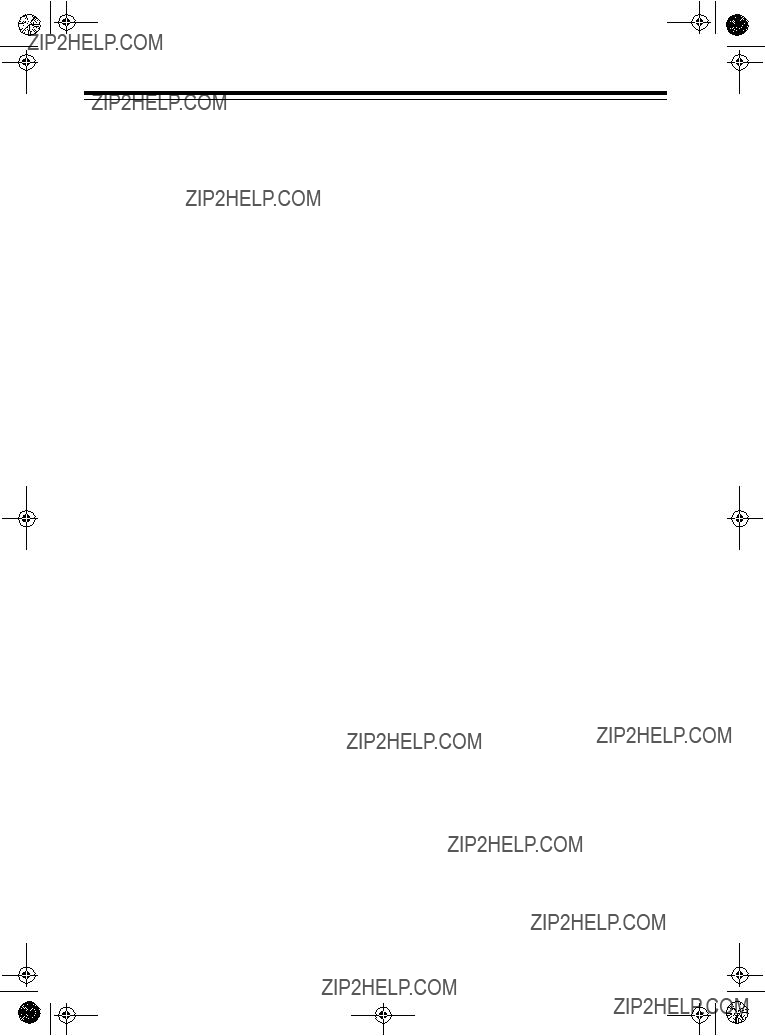
CONTENTS

5

BEFORE YOU BEGIN
Please read this owner???s manual carefully. It has been prepared to help you with initial setup pro- cedures and in the everyday operation of your camcorder.
SUPPLIED ACCESSORIES
Your camcorder includes the following accesso- ries. Be sure to remove these items before you store the packing material.
Battery Pack ??? supplies power for recording and playback during portable operation.
AC Adapter/Charger ??? charges the battery or, when used with the auxiliary power cord, sup- plies power to the camcorder from an AC outlet.
Auxiliary Power Cord ??? lets you connect the camcorder to the AC adapter/charger to operate the camcorder from AC power.
OPTIONAL ACCESSORIES
DC Adapter (CMC No.
RF Adapter Kit (CMC No.
???One RF converter
???One 300- to
???One
Spare Battery Pack (CMC No.
Telephoto/Wide Angle Lens (CMC No. 16- 2339)
Shoulder Strap ??? provides a convenient way to carry the camcorder.
Filter Kit (CMC No. (please add))
6

MOISTURE CONDENSATION
Condensation inside the camcorder can cause tape jams or video head damage. If the cam- corder senses moisture, TAPE flashes in the viewfinder.
If TAPE flashes in the viewfinder, or when you first use your camcorder after moving it from a cold area to a warm one, follow these steps.
1.Eject the cassette if one is installed.
2.If necessary, slide POWER to OFF.
3.Let the camcorder sit for about 1 hour before you begin operation.
Caution: Avoid using the camcorder in exces- sively humid areas.
7
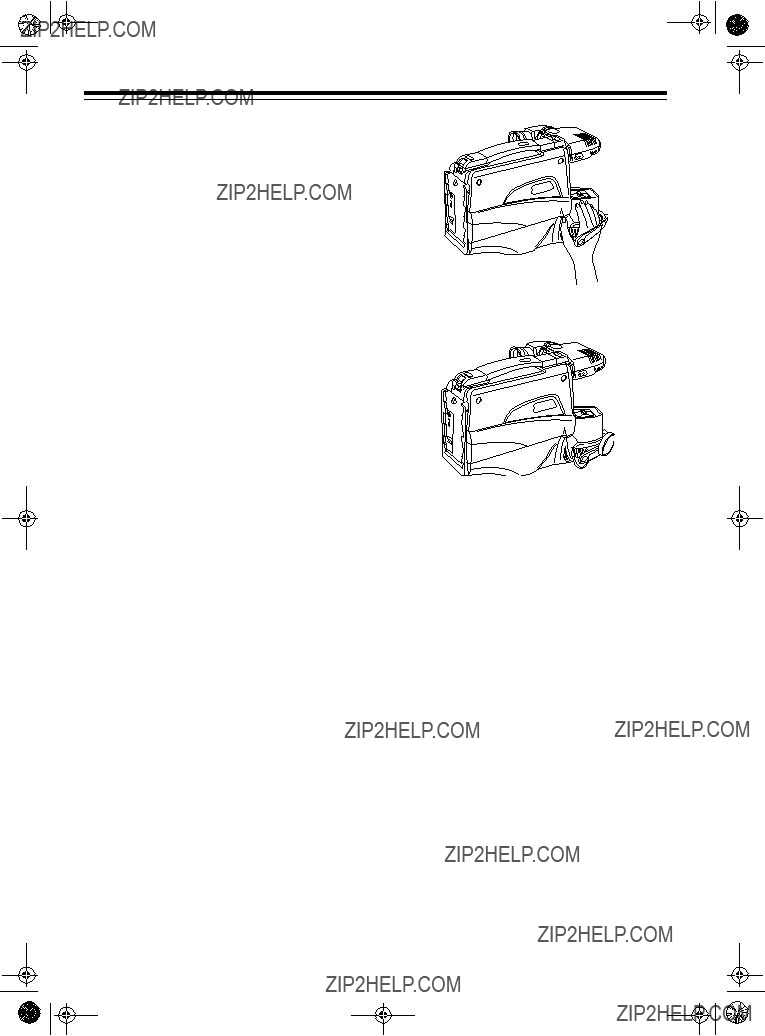
QUICK START
To eliminate complicated adjustments in most situations, this camcorder has fully automatic features for focus, white balance, and shutter speed. All you need to do is press REC/PAUSE.
The following steps outline the basic procedures for making a recording. In many of the steps, you are directed to a specific section of this manual that contains more detailed information. When operating the camcorder for the first time, read all the steps and the suggested detailed in- formation before you actually begin.
1.Choose and connect a power source. See ???Selecting a Power Source??? on Page 10.
2.Press STOP/EJECT to open the cassette compartment. Insert a standard VHS cas- sette, and close the compartment. See ???Inserting/Removing a Video Cassette??? on Page 16.
3.Slide POWER to CAMERA. The POWER indicator lights. See ???Setting the Power Switch on Page 17.
Note: If there is no cassette in the cam- corder, NO TAPE appears in the view- finder. If the cassette has its erase- protection tab broken off, TAPE appears in the viewfinder. See ???Erase Protection??? on Page 39.
4.Adjust the viewfinder???s position until you can look into it comfortably when the back of the camcorder rests on your right shoul- der. Then adjust the focus control on the eyepiece for the sharpest picture in the viewfinder. See ???Preparing/Adjusting the Viewfinder??? on Page 14.
5.Place your right hand between the hand strap and the camcorder. Then adjust the hand strap so it fits tightly over your hand.
Note: If the strap is too loose, the cam- corder is difficult to handle.
6.Remove the lens cap and hang it on the hand strap clip.
7.Point the camcorder at the desired subject, then press W or T on the power zoom con- trol until you see the desired picture in the viewfinder. See ???Variable Speed Power Zoom??? on Page 21.
8.To begin recording, press REC/PAUSE with your right middle finger. During recording, REC appears in the viewfinder with arrows above it to show the direction of tape travel.
Note: When about 5 minutes or less remain on the tape, TAPE END flashes in the viewfinder.
9.To pause the tape, press REC/PAUSE again. The tape pauses, the arrows disap-
pear, and appears in the viewfinder. To continue recording, press REC/PAUSE again.
8
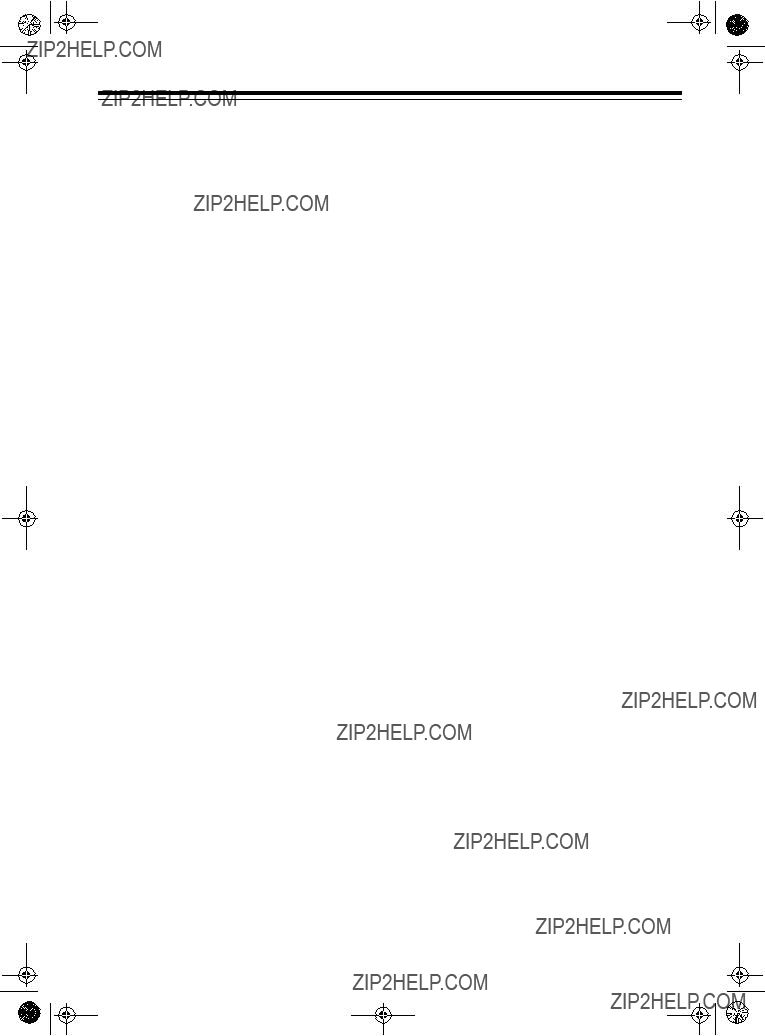
Notes:
???To protect the tape and conserve battery power, the camcorder turns itself off if you pause the tape for more than 5 minutes. To turn the camcorder back on, press REC/
PAUSE.
???For more information about recording with your camcorder, be sure to read all the sec- tions under ???Special Video Recording Fea- tures??? on Page 18.
VIEWFINDER PLAYBACK
After you make a recording, you can play it back through the viewfinder. (Of course, you can also press STOP/EJECT, remove the tape, and play it in any VHS VCR).
1.Slide POWER to VCR. The POWER indica- tor lights.
2.Press REWIND to return the tape to the beginning or to the place where you want to begin playback. See ???Digital Counter??? on Page 21.
3.Press PLAY and watch the picture in the viewfinder. See ???Special VCR Features??? on Page 26.
Note: You cannot hear the tape???s audio recording during viewfinder playback. To hear sound, play the tape through a TV/ monitor or on a VCR. See ???Connecting the Camcorder to a TV??? on Page 32.
4.Press STOP/EJECT to end playback.
5.To remove the cassette, press STOP/EJECT again.
Note: Except when you are recording, you can eject a cassette any time power is con- nected to the camcorder, whether or not the POWER indicator is lighted.
9
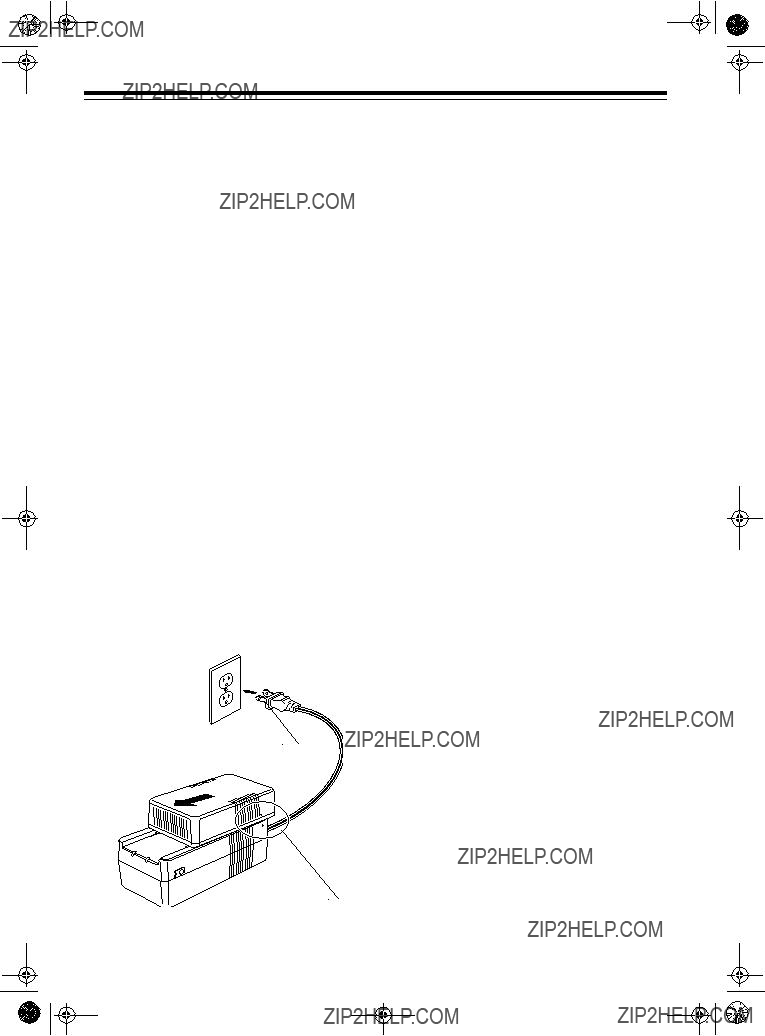
SELECTING A POWER SOURCE
You can power the camcorder from any of three sources ??? the supplied battery pack, the sup- plied AC adapter/charger, or your vehicle???s bat- tery (with an optional DC adapter, not supplied).
Note: Your camcorder has a
USING THE BATTERY PACK
You can power the camcorder using the sup- plied battery pack. However, you must charge the battery pack before you use it.
Charging the Battery Pack
Caution: Use only the supplied AC adapter/ charger to charge the battery pack. Use of any other adapter/charger could damage the battery pack. Also, do not use the AC adapter/charger to charge any battery pack other than the type supplied.
Follow these steps to charge the battery pack with the supplied AC adapter/charger.
To AC Outlet
1.Make sure the auxiliary power cord is not connected to the AC adapter/charger.
Note: The battery pack will not charge if the auxiliary power cord is connected to the AC adapter/charger.
2.Align the marks on both sides of the battery pack with the marks on both sides of the AC adapter/charger.
3.Gently press the battery pack against the AC adapter/charger, then slide the battery pack toward you until it locks into place.
Caution: The battery pack fits only one way onto the AC adapter/charger. Do not force it.
4.Plug the AC adapter/charger???s power cord into a standard AC outlet. The POWER and CHARGE indicators on the AC adapter/ charger light, and charging begins. When the battery pack is fully charged, the CHARGE indicator turns off.
Caution: If the battery pack is hot, wait until it cools before connecting it to the AC adapter/charger. Otherwise, the CHARGE indicator might not light.
Notes:
???If the POWER and CHARGE indicators on the AC adapter/charger flash, remove the battery pack from the AC adapter/ charger, then
???It takes about 2 hours to fully charge the battery pack, but the exact charging time depends on the ambient temperature and the condition of the battery pack.
5.When the battery pack is fully charged, remove it from the AC adapter/charger by sliding it away from you. Then disconnect the AC adapter/charger from the AC outlet.
Alignment Marks
10
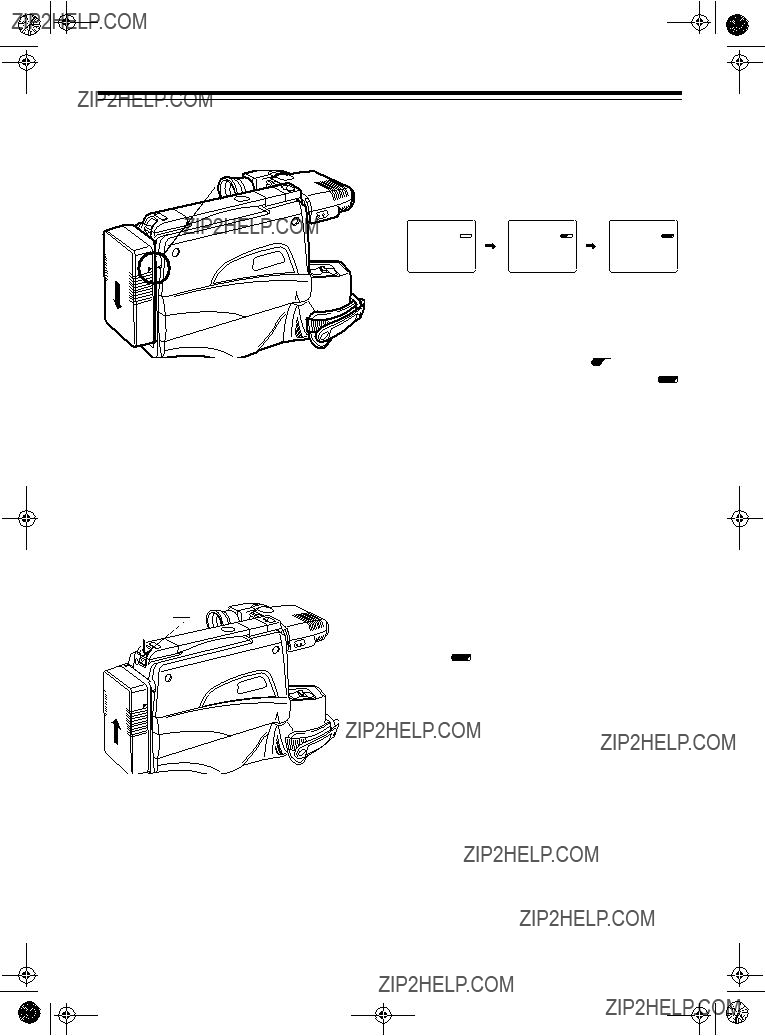
Attaching the Battery Pack to the Camcorder
Alignment Marks
1.Align the marks on both sides of the battery pack with the marks on the sides of the camcorder.
2.Gently press the battery pack against the camcorder, then slide the battery pack down until it clicks and locks in place.
Caution: The battery pack fits only one way onto the camcorder. Do not force it.
tery pack. You might damage the tape if you remove the battery pack during record- ing or playback.
Battery Status Indicators
When the battery pack is fully charged,  appears in the viewfinder when you slide POW- ER to CAMERA.
appears in the viewfinder when you slide POW- ER to CAMERA.
blinks in the viewfinder. Then, after a few sec- onds, the camcorder turns itself off. Recharge the battery pack or power the camcorder from the supplied AC adapter/charger or an optional DC adapter.
Note: You can order additional battery packs from your local Radio Shack store so you can use one battery while you charge another.
Removing the Battery Pack from the Camcorder
BATTERY
1.Slide POWER to OFF to turn off the cam- corder.
2.While pressing and holding down BATTERY, slide the battery pack up to remove it.
Caution: Always stop the tape and turn off the camcorder before you remove the bat-
Replacing the Battery Pack
While Recording
You can replace the battery pack with a fresh one while recording.
recording, press REC/PAUSE to stop recording.
2.If the camcorder is still on, slide POWER to OFF. The POWER indicator turns off.
Caution: Be sure the POWER indicator is off before you remove the battery pack.
3.Remove the old battery pack and attach a fresh one.
4.Slide POWER to CAMERA. The POWER indicator turns on.
5.Press REC/PAUSE to continue recording
from the same place as before.
11

Battery Usage Hints
???Recording with many starts and stops, fre- quent zooming, and recording in low tem- peratures might shorten battery life. Be sure to slide POWER on the camcorder to OFF when not recording.
???Do not use the camcorder with a low or dis- charged battery pack attached. This might cause the camcorder to automatically stop during recording or playback, possibly damaging the tape, battery pack, and cam- corder.
???The camcorder consumes a small amount of battery power even when POWER is set to OFF. If you are not going to use the cam- corder for a long time, remove the battery pack from the camcorder.
???Recharge the battery pack immediately after you record. Leaving the battery dis- charged can damage it, preventing further recharging and use.
???If you recharged the battery pack then stored it for a long period of time, recharge it again before you connect it to the cam- corder. Batteries stored for an extended time lose some power, resulting in decreased battery life and recording time.
???Recharge the battery pack at least once every 6 months, even when it is not used.
???Store the battery pack in a dry, cool place.
Important: This product contains a recharge- able
USING THE AC ADAPTER/
CHARGER
1.Connect one end of the supplied auxiliary power cord to the AC adapter/charger???s DC OUTPUT jack.
2.Connect the other end of the auxiliary power cord to the DC IN jack on the back of the camcorder.
3.Plug the AC adapter/charger???s power cord into an AC outlet.
Caution: The supplied AC adapter/charger is specially designed for use with your camcorder. Never use it to power any other device
12
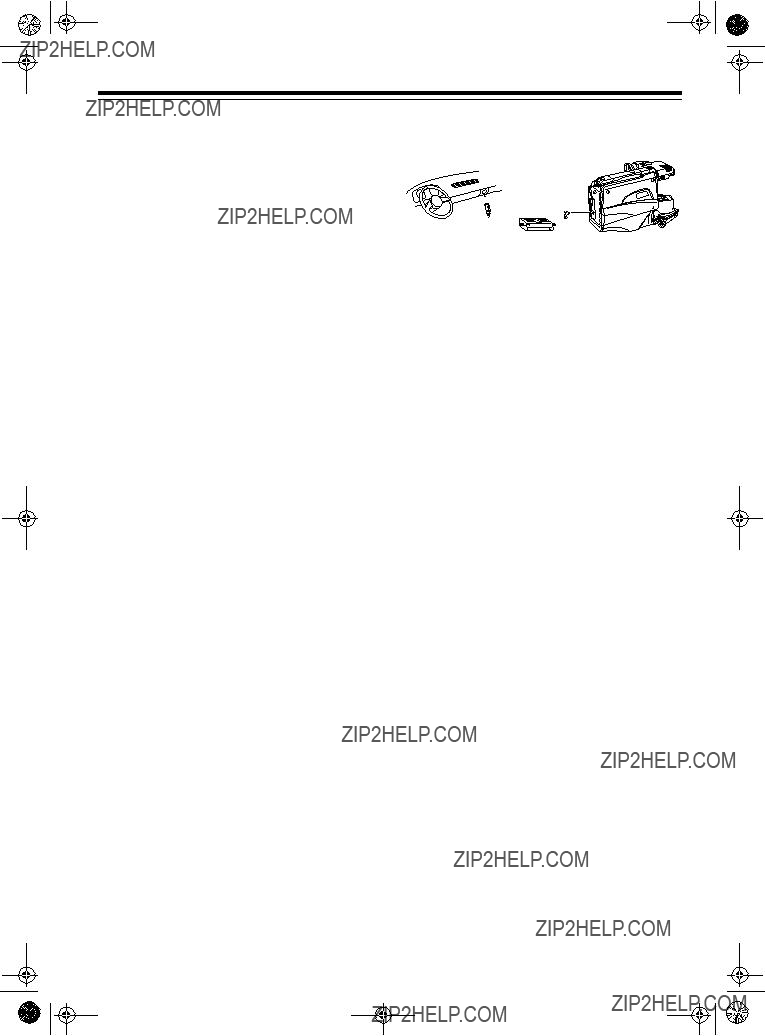
USING AN OPTIONAL DC
ADAPTER
You can use a DC adapter (CMC No. T16- CC70A, not supplied) to power your camcorder.
Cautions:
???Your vehicle must have a
???The recommended DC adapter is specially designed for use with your camcorder. Never use it to power any other device.
???Use only the recommended DC adapter to power the camcorder from your vehicle. Using a DC adapter other than the recom- mended DC adapter could seriously dam- age your camcorder and the DC adapter.
???Always connect the DC adapter to the cam- corder before you plug it into your vehicle???s
Follow these steps to power the camcorder from your vehicle???s battery:
1.Connect the DC adapter???s barrel plug to the DC IN jack on the back of the camcorder.
2.Plug the DC adapter into your vehicle???s cig-
Notes:
???Be sure to push the plug completely into the
???Be sure the socket is free from ashes and other debris.
13
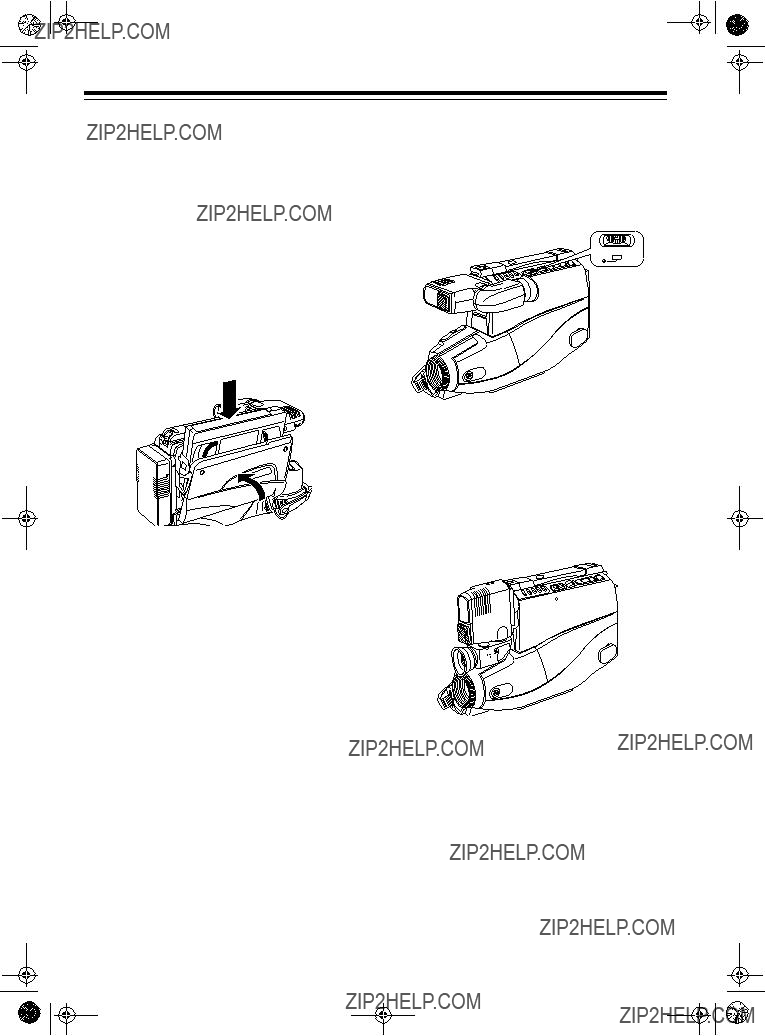
PREPARING THE CAMCORDER FOR USE
INSERTING/REMOVING A
VIDEO CASSETTE
You can open the cassette compartment to in- sert/remove a video cassette whenever a power source is connected to the camcorder, whether or not the camcorder is turned on.
1.Press STOP/EJECT to open the cassette compartment.
2.Insert a VHS cassette into the cassette compartment with the side label facing you and the spine label facing up, then gently press the cassette compartment door until it closes.
Caution: Never insert anything except a VHS video cassette into the cassette com- partment.
To remove a cassette, press STOP/EJECT, wait for the cassette compartment door to open, and pull out the cassette.
Caution: Always remove the cassette before storing the camcorder.
SETTING THE POWER SWITCH
While pressing and holding down the red button in the center of POWER, slide it to CAMERA for video recording or to VCR for playback. The POWER indicator lights.
CAM OFF VIDEO
POWER
Slide POWER to OFF to turn off the camcorder.
PREPARING/ADJUSTING THE
VIEWFINDER
The camcorder???s viewfinder is set to this posi- tion at the factory.
Before you carry the camcorder by its shoulder strap or store it, return the viewfinder to this po- sition (see ???Setup??? on Page 17).
14

Setup
Before you can use the camcorder, you must set up the viewfinder.
1.Rotate the viewfinder support until it stops, as shown.
Caution: The viewfinder support rotates only 90??. Do not force it past this point.
2.Rotate the eyepiece about 180?? until it stops, as shown.
Caution: The eyepiece rotates only about 225??. Do not force it past this point.
Adjustment
Once you set up the viewfinder, you can adjust the position of the viewfinder support and angle of the eyepiece, so you can see through the eyepiece easily.
1.Slide POWER to CAMERA or VCR.
2.To adjust the viewfinder support, slide it to the left or right until the eyepiece is directly in front of your right eye.
3.To adjust the eyepiece, rotate it up or down until you can see through it.
4.Turn the focus control on the right side of the eyepiece until the image is clear and sharp.
Focus Control
15

SETTING/CHANGING
THE DATE AND TIME
1.Slide POWER to CAMERA. The POWER indicator lights.
2.If the currently set date does not appear in the viewfinder, repeatedly press DATE/TIME until the date appears and the month???s digit flashes.
If the month???s digit does not flash, press and hold down DATE/TIME, then press
STOP/EJECT once.
3.Repeatedly press
4.When the viewfinder shows the correct month, press STOP/EJECT. The day???s digit flashes.
12:00AM??? ???
11 1 1995
??? ???
5.Repeat Steps
6.When you have set the date and time, repeatedly press DATE/TIME to confirm the information you set.
7.To change the displayed date and time, repeat Steps
16

ATTACHING THE SHOULDER
STRAP
The shoulder strap provides a convenient way to carry the camcorder when it is not in use. You can also use it as a safety strap when you use the camcorder.
To attach the shoulder strap, slide POWER to OFF, then attach each end of the strap as shown.
Cautions:
???Use only the supplied shoulder strap with this camcorder.
???Do not swing the camcorder from the shoulder strap.
???Replace the lens cap while carrying the camcorder with the shoulder strap.
17
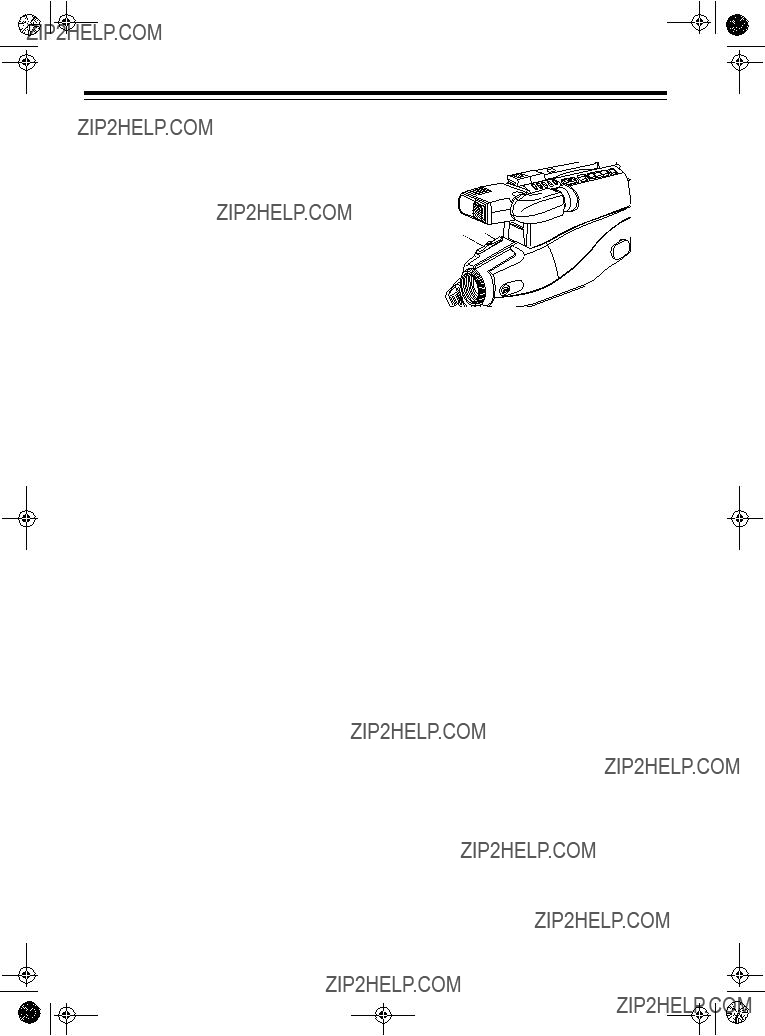
SPECIAL VIDEO RECORDING FEATURES
AUTO FOCUSING
The automatic focusing feature lets you concen- trate on recording great videos without having to worry about whether or not they are properly fo- cused.
The camcorder detects the distance from the camcorder to the object you see in the center of the viewfinder, then sets the focus for that dis- tance. When you move the camcorder, the cam- corder continuously adjusts the focus to maintain the sharpest picture. Try to keep your desired subject in the middle of the viewfinder.
Notes:
???If the lens gets dirty, clean it with a soft tis- sue and
???If the lens gets damp, dry it with a soft cloth or wait until the moisture evaporates.
???Always replace the lens cap when you fin- ish recording.
???The
??? You are taping in extremely low light.
VARIABLE SPEED
POWER ZOOM
W T 
The
As you zoom out or in, a bar with an indicator ap- pears on the left side of the viewfinder. The indi- cator moves up and down the bar, showing the relative zoom position. The pressure you place on W and T controls the speed of the zoom. The harder you press W and T, the faster the cam- corder zooms.
???You are taping in snow or fog.
???Close and distant objects are both near the center of the viewfinder.
???You are taping a long object (such as a fence rail) from its end.
???The scene includes several objects equal distances apart.
???Light reflects off the subject.
???The focus point moves rapidly.
???You are taping through a window.
MACRO FOCUSING
The camcorder???s macro focusing feature lets you shoot close up pictures (as little as 11/4 inch- es away) of objects such as flowers, printed ma- terial, or photos in your family album.
To use macro focus, press and hold down W (see ???Variable Speed Power Zoom??? above) until you see the widest possible angle in the view- finder, then aim the camcorder at the object you are shooting. In most cases, the camcorder au- tomatically focuses on the subject.
Notes:
???Since macro focus exaggerates even the slightest movement of the camcorder or subject, we recommend that you set the camcorder on a tripod while using macro focus.
18

???For the best possible resolution while using macro focus, be sure to shoot in a well- lighted area.
DIGITAL ZOOM
The camcorder???s digital zoom feature automati- cally doubles the magnification of telephoto shots while you use variable speed power zoom.
To use digital zoom, simply continue to press and hold down T while you are zooming. As you press and hold down T, the magnification dou- bles and ZOOM appears above the indicator on the left side of the viewfinder.
Notes:
???The subject you are magnifying while using digital zoom might appear coarse. This is normal.
???Since digital zoom exaggerates even the slightest movement of the camcorder or subject, we recommend that you set the camcorder on a tripod while using digital zoom.
FADE IN AND FADE OUT
To give your recordings a professional look, the camcorder has three fade options.
To select a fade option and fade in or out, re- peatedly press FADE during recording or while the camcorder is paused until the icon for the option you want appears. Then press REC/
PAUSE.
Note: During fade, the recorded audio also fades in/out along with the video.
The camcorder has the following fade options:
White fade: The picture fades in/out from/to a white screen. When you select this option, 

 appears in the upper left corner of the
appears in the upper left corner of the
viewfinder.
Fade In
Fade Out
Wipe fade: The picture opens/closes gradually from/to the center of a black screen. When you select this option, 

 appears in the upper left corner of the viewfinder.
appears in the upper left corner of the viewfinder.
Fade In
Fade Out
Zoom fade: The picture fades in/out while zooming from/to a white screen. When you se- lect this option, appears in the upper left corner of the viewfinder.
Fade In
Fade Out
19
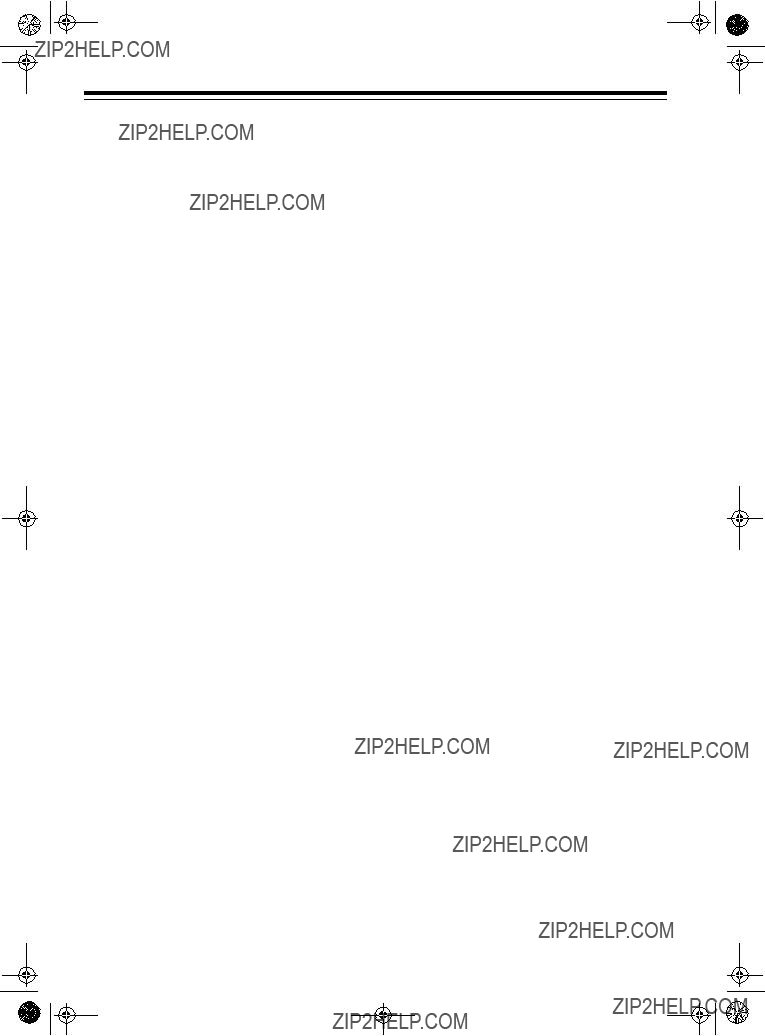
REVIEW
This feature lets you quickly review the last few seconds of a recording.
1. During recording, press REC/PAUSE to stop the tape. appears in the viewfinder.
2.Press REVIEW. The tape rewinds and plays the last few seconds of the tape, then stops the tape where the recording ends.
3.Press REC/PAUSE to resume recording from that point.
CAMERA SEARCH
The camera search feature lets you review re- corded portions of a tape and resume recording at the desired point on the tape. This lets you smoothly connect recorded scenes.
1. During recording, press REC/PAUSE to stop the tape. appears in the viewfinder.
2.Press and hold down
3.When you see the approximate place on the tape where you want to start recording, continue to press and hold down
4.Press and hold down PLAY to position the tape at the exact place where you want to start recording. When you locate the exact place, release PLAY to stop the tape.
5.Press REC/PAUSE to start recording at the desired position on the tape.
AUTO EXPOSURE
Depending on the brightness of the subject, the camcorder automatically sets its shutter speed to one of the following speeds:
???1/60
???1/100
???1/120
???1/180
???1/250
???1/350
???1/500
???1/750
???1/1000
???1/1500
???1/2000
???1/4000
The iris in the camcorder???s lens also adjusts au- tomatically in response to the shutter speed.
The camcorder displays AE and the current shutter speed in the upper left corner of the viewfinder.
AUTOMATIC INDEX
Indexing makes it easy to find each recording on a tape using a VCR with the VHS Index Search System (VISS) feature.
Note: For more information about VISS, refer to your VCR???s owner???s manual.
The camcorder automatically records VISS in- dex signals when:
???You turn on the camcorder???s power within about 4 hours after you last turned it off, then start recording.
???You turn on the camcorder???s power after the date changed to the next day while the power was off, then start recording.
When the camcorder records a VISS index sig- nal, INDEX appears in the viewfinder until you start recording.
20
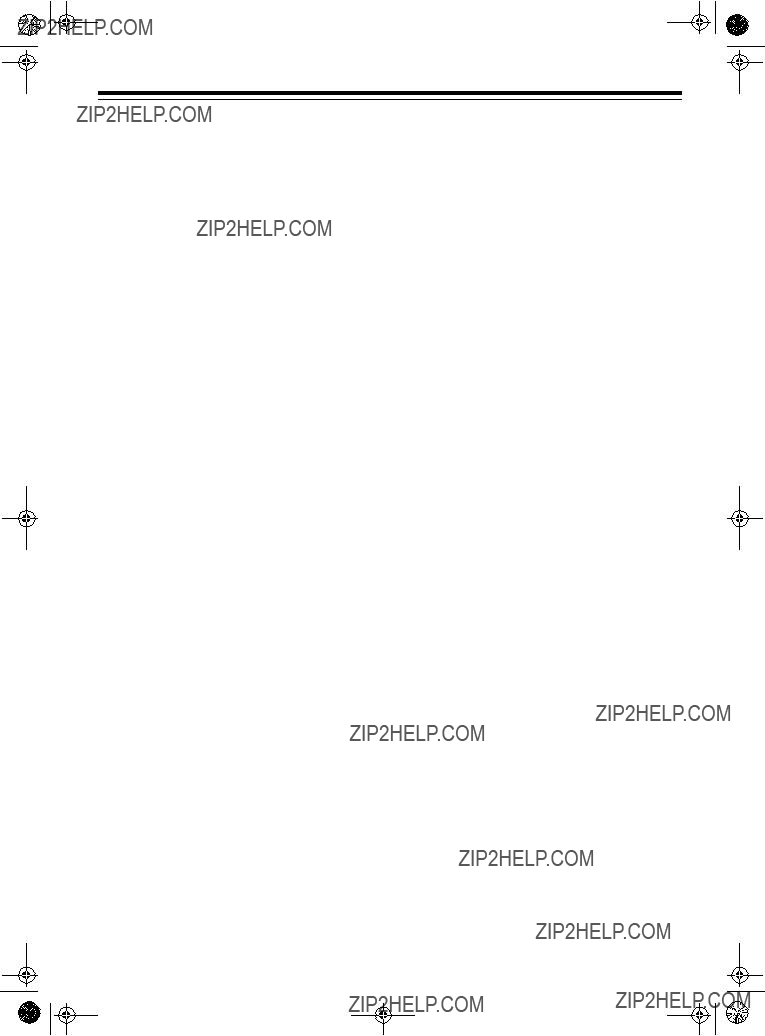
RECORDING THE DATE
AND TIME ON A TAPE
You can select a date/time recording option by repeatedly pressing DATE/TIME. Each time you press DATE/TIME, you see one of the following options:
???

 and the date ??? the camcorder automatically records the date on the first 10 seconds of the first recording of the day.
and the date ??? the camcorder automatically records the date on the first 10 seconds of the first recording of the day.
???Date only ??? the camcorder continuously records the date.
???No date/time display ??? the camcorder does not record the date or time.
???Time and date ??? the camcorder continu- ously records the date and time.
Notes:
???The camcorder records the same date when:
???You replace the cassette
???You select another date/time option, then select the auto date option
???The previous recording was less than 10 seconds long
???If the date changes while recording con- tinues for more than 10 seconds, the new date is recorded at the beginning of the next recording.
DIGITAL COUNTER
The camcorder displays a digital tape counter in the upper right corner of the viewfinder during recording or playback. You can use this counter to mark and return to specific locations on a tape. The camcorder does not record the digital counter onto the tape.
1.Load a cassette into the camcorder, then slide POWER to CAMERA or VCR. The counter appears in the viewfinder.
2.Rewind the tape in the camcorder, then press RESET. The counter resets to 0000.
3.Begin recording or playback of the tape.
4.While recording or playing back, if you see a place on the tape you might want to return to, note the counter reading at that point.
COUNTER MEMORY
This feature lets you rewind or
1.Load a cassette into the camcorder, then slide POWER to CAMERA or VCR. The counter appears in the viewfinder.
2.Press DISPLAY. M appears next to the counter in the viewfinder.
3.Begin recording or playback of the tape. When you see a scene you might want to return to, press RESET. The counter resets to 0000.
4.When you are ready to return to the loca- tion on the tape where you pressed RESET, follow these steps if you are recording:
a.Press REC/PAUSE
b.Slide POWER to VCR
c.Press REWIND or
If you are playing back a tape, press STOP/ EJECT, then press REWIND or
The tape rewinds or
To rewind or
21

TAPE REMAINING
8990
During recording and playback, the camcorder displays a bar below the tape counter in the viewfinder showing the amount of tape left on the loaded cassette. The camcorder displays re- maining tape information in ranges from
(the tape is at or near the beginning),
(the tape is in or near the middle), to  (the tape is at or near the end).
(the tape is at or near the end).
Notes:
???When there is less than 5 minutes of tape left, TAPE END also flashes in the view- finder.
???When you first record or play back a cas-
sette, the camcorder displays for about 10 seconds. Then the bar changes to show the remaining amount of tape.
???The remaining tape bar disappears when you eject the cassette.
TITLER
You can easily create and record personalized titles on your recordings using the camcorder???s titler.
The camcorder stores up to two title ???pages??? in its memory. Once you store a title, you can dis- play and record it onto a tape any time. Each title page can contain up to two lines of 16 charac- ters each.
The titler contains 47 different characters you can use to create titles.
Creating Titles
Follow these steps to create titles and save them in the camcorder???s memory (one title per page).
Note: You cannot load or eject a cassette while creating a title.
1.Slide POWER to CAMERA or VCR.
2.Press TITLE.
A flashing cursor appears in the viewfinder.
3.Repeatedly press SHIFT to move the flash- ing cursor to the place where you want to begin your title.
4.Select the first character of your title by repeatedly pressing ??? or + to move back- ward or forward through the characters until the viewfinder shows the correct character. To quickly move backward or forward through the characters, press and hold down ??? or +.
22
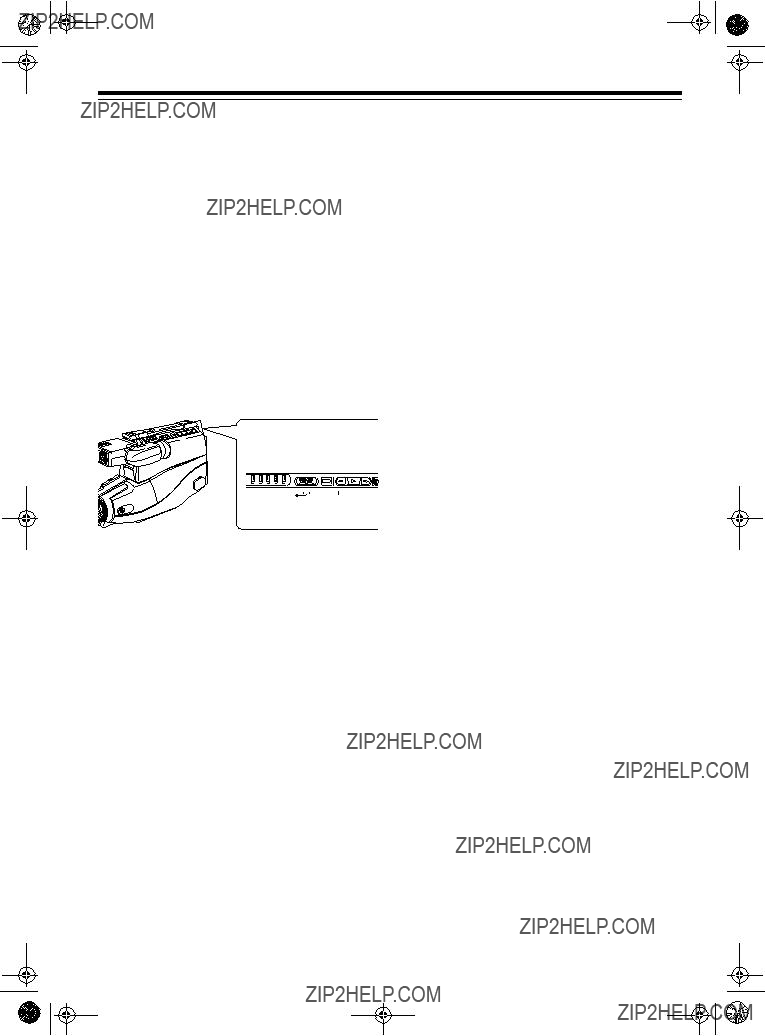
The characters appear in this order as you press + (or in reverse order as you press ??? ).
A B C D E F G H I J K L M N O P Q R S T U V W X Y Z 0 1 2 3 4 5 6 7 8 9? ???. /,
5.After you have selected the first character, press SHIFT to move the flashing cursor to the place where you want the next charac- ter.
6.Repeat Steps 4 and 5 until you complete the title.
Note: The last character you select might flash in the viewfinder, but it will not flash when you save it.
7.If you like, you can press PAGE then repeat Steps
Editing Titles
Follow these steps to change a title.
1.Press TITLE. Then, if the title page you want to correct does not appear, press PAGE to select the other title page.
2.Repeatedly press SHIFT to move forward through the characters until the incorrect character flashes.
3.Repeatedly press ??? or + to move backward or forward through the characters until the viewfinder shows the correct character. To quickly move backward or forward through the characters, press and hold down ??? or +.
4.If necessary, repeat Steps 2 and 3 to select and correct other characters.
8.To save and review the titles you created, press TITLE. The last title page you created appears, and the first character of the title flashes. To view the other title page (if you created one), press PAGE.
Notes:
???Your camcorder???s
???The camcorder saves the titles you created when it automatically stops and turns itself off after 5 minutes.
Adding Titles While Recording
You can use the camcorder to superimpose (add) titles to your recordings while you record.
Note: You cannot use these steps to superim- pose titles over material previously recorded. You can do this while you dub a tape. See ???Add- ing Titles onto an Existing Recording??? on Page 31.
1.Slide POWER to VCR.
2.Locate the position on the tape where you want to record a title.
3.Slide POWER to CAMERA.
4.Press TITLE. Then, if the title page you want to record does not appear, press PAGE to select the other title page.
5.Press REC/PAUSE to start the title record- ing.
The camcorder superimposes the title you selected over the scene you are recording.
6.When you want to stop recording the title onto the tape, press TITLE. The title disap- pears.
23

HINTS FOR MAKING BETTER VIDEO TAPES
If you are not familiar with camera techniques, there are many books about the subject avail- able at your local library. However, because the camcorder is so simple to use and tape can be used again and again, it is inexpensive to exper- iment and learn as you go.
The following information will get you started.
LIGHTING
Lighting should be uniform. The camcorder can record in
Caution: Do not place a light source near the camcorder. The heat can damage the camcord- er.
The chart at right shows you the approximate brightness in different situations or from differ- ent light sources.
Typical Brightness
of Common Situations
24

CAMCORDER MOVEMENT
When you move the camcorder while recording, do so slowly and steadily. Too much movement or fast movement make your recordings look awkward. A video camera tripod (such as Radio Shack Cat. No.
ZOOM IN AND ZOOM OUT
As with movement, too much use of the cam- corder???s zoom features can detract from your re- cordings. When you use variable speed power zoom and/or digital zoom, it is best to zoom in or zoom out in one smooth motion, not in several jerky motions.
If you use them sparingly, movements from side to side combined with zooms can be very effec- tive in your video tapes.
25

SPECIAL VCR FEATURES
This section describes some of your camcord- er???s special VCR features and functions.
Note: Unless otherwise noted, you can use these features only when POWER is set to VCR.
Note: You cannot view the tape or hear the tape???s sound while you
VISUAL SEARCH
Visual search lets you view a recording either forward or backward at a faster speed so you can find a specific section of the tape.
To search forward during playback, press FAST- F. To search backward during playback, press
REWIND.
To stop visual search and play the tape, press
PLAY.
Note: You cannot hear the tape???s sound during visual search.
FREEZE FRAME
To freeze a frame during playback, press REC/ PAUSE. To return to the normal playback speed, press REC/PAUSE again.
Notes:
???During
???If you leave the VCR in the
FAST FORWARD AND REWIND
To advance the tape quickly when it is stopped, press

REWIND
AUTO TRACKING
The camcorder automatically adjusts tracking when you play a tape. However, you can manu- ally adjust the tracking if the camcorder???s picture is poor. Repeatedly press W or T during play- back to manually adjust the tracking.
Note: The camcorder resets to auto tracking when you load another tape.
26

DUBBING (COPYING) A TAPE
The process of recording from one audio/video device to another is called dubbing.
You can connect the camcorder and the VCR together, then either:
???Use your camcorder to record the signal from the VCR
???Use your VCR to record the signal from the camcorder
Notes:
???Always use video quality shielded cables with
???Do not use standard audio cables for this connection.
???You can monitor the dubbing on the TV connected to your VCR. See your VCR???s owner???s manual for more information.
If you want to use your camcorder to record from the VCR, see ???Dubbing to the Camcorder??? on Page 27. If you want to use your VCR to record from the camcorder, see ???Dubbing from the Camcorder??? on Page 28.
Dubbing to the Camcorder
Follow these steps to connect the camcorder to the VCR and copy a tape from the VCR to the cam- corder.
Note: You can also use this procedure to record broadcasts from your cable box, satellite receiver, or other audio/video source. Simply connect the camcorder???s AUDIO and VIDEO jacks to the output jacks on the audio/video source (instead of the VCR) in Step 3.
27
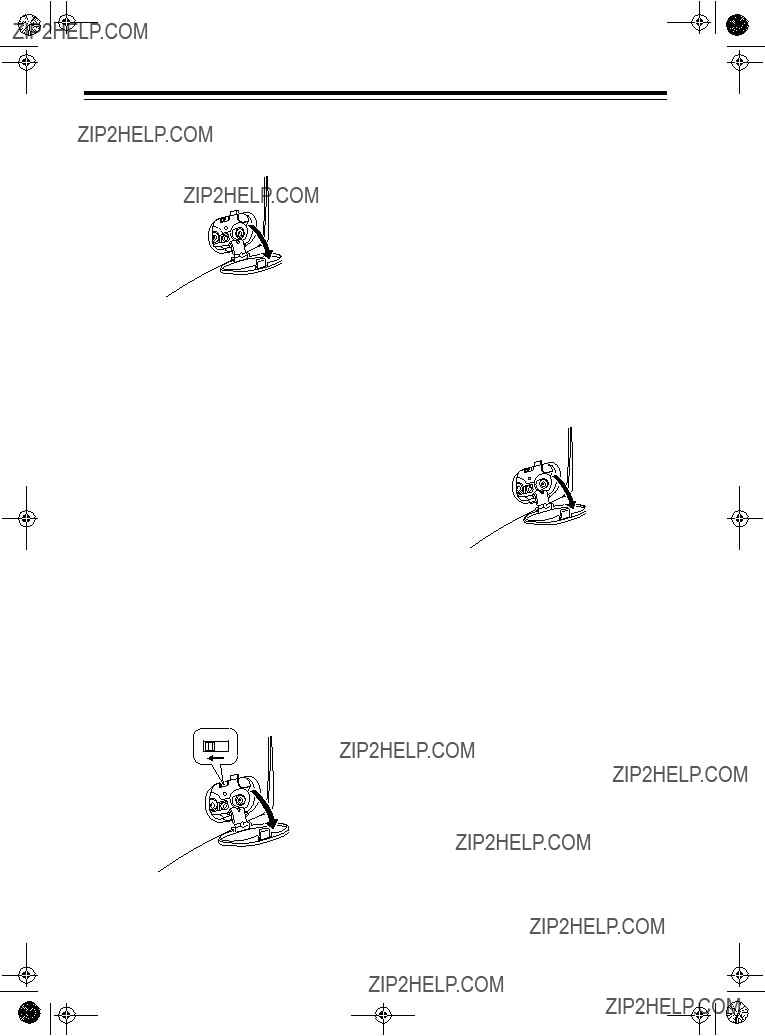
1.Use a fingernail to pull down the cover on the camcorder???s AUDIO/VIDEO OUT/IN jack compartment to open it.
Caution: The cover on the AUDIO/VIDEO OUT/IN jack compartment is attached to the camcorder. Do not try to remove it.
2.Connect the white plug on one end of the cable to the camcorder???s AUDIO jack, then connect the yellow plug on the same end of the cable to the camcorder???s VIDEO jack.
3.Connect the white plug on the other end of the cable to the VCR???s AUDIO OUT jack. Then connect the yellow plug on the same end of the cable to the VCR???s VIDEO OUT jack.
4.Set AV OUT/IN inside the AUDIO/VIDEO OUT/IN jack compartment to IN.
IN OUT
5. Slide POWER to CAMERA.
6.Insert a cassette into the camcorder.
7.Begin playback on the VCR or audio/video source.
8.Press REC/PAUSE on the camcorder to start dubbing.
9.Press REC/PAUSE on the camcorder to stop dubbing.
Dubbing from the Camcorder
Follow these steps to connect the camcorder to the VCR and copy a tape from the camcorder to the VCR.
1.Use a fingernail to pull down the cover on the camcorder???s AUDIO/VIDEO OUT/IN jack compartment to open it.
Caution: The cover on the AUDIO/VIDEO OUT/IN jack compartment is attached to the camcorder. Do not try to remove it.
2.Connect the white plug on one end of the cable to the camcorder???s AUDIO jack, then connect the yellow plug on the same end of the cable to the camcorder???s VIDEO jack.
3.Connect the white plug on the other end of the cable to the VCR???s AUDIO IN jack. If your VCR is a stereo VCR, use a
28

4.Set AV OUT/IN inside the AUDIO/VIDEO OUT/IN jack compartment to OUT.
5.Slide POWER to VCR.
6.Insert a cassette into the camcorder.
7.Set your VCR to its audio/video mode.
Note: Some VCRs have a manual input- select switch, while others automatically ???sense??? when you connect another audio/ video source to the VCR???s audio/video input jacks. Check your VCR???s owner???s manual for more information about your VCR.
8.Press PLAY on the camcorder to find the portion of the tape you want to dub. Then press REC/PAUSE to pause it.
9.Set the VCR to record, then press the VCR???s record button to begin recording.
10.Press REC/PAUSE on the camcorder to play the portion of the tape you want to dub.
11.Press REC/PAUSE on the camcorder to stop dubbing.
Adding Titles onto an Existing Recording
Note: You need a separate VHS VCR to super- impose titles over an existing recording.
1.Connect the camcorder and VCR (see ???Dubbing from the Camcorder??? on Page 28.).
2.Press TITLE to select the title you want to record. Then, if the title you want to record does not appear, press PAGE to select the other title page.
3.Press TITLE to remove the title from the viewfinder. The title disappears.
4.Load a blank cassette, or one you want to record onto, into the VCR. Then set the VCR to its recording mode.
5.Load the cassette you want to record from into the camcorder, then press PLAY to play it back.
6.When you see the scene where you want to record the title, press TITLE. The cam- corder plays the title and superimposes it over the recording.
7.When you want to stop recording the title onto the tape, press TITLE. The title disap- pears.
AUDIO EDITING
The camcorder???s audio editing feature lets you record a new soundtrack onto a previously re- corded tape without erasing the original picture.
When you use audio editing, you replace the au- dio on the tape with new sound. You can use sounds picked up by the camcorder???s
Notes:
???If you connect an audio source, always use video quality shielded cables with phono- type connectors (such as Cat. No.
???Do not use a standard audio cable for this connection.
1.If you are not using the camcorder???s
29

2.Set AV OUT/IN inside the AUDIO/VIDEO OUT/IN jack compartment for the audio source you chose:
IN OUT
???If you are using the
???If you are using an audio source con- nected to the camcorder???s AUDIO jack, set AV OUT/IN to IN.
3.Slide POWER to VCR.
4.Insert a cassette into the camcorder.
5.Press PLAY on the camcorder to find the portion of the tape where you want to start audio dubbing. Then press REC/PAUSE to pause it.
6.Press PLAY and DUBBING AUDIO/VIDEO
viewfinder, press STOP/EJECT, then press
PLAY and DUBBING AUDIO/VIDEO together once to continue.
7.If you are not using the camcorder???s
8.To start audio dubbing, press REC/PAUSE on the camcorder.
9.Press STOP/EJECT on the camcorder to stop dubbing.
Notes:
???To set the position where you want to end audio dubbing, start playback of the tape, press DISPLAY on the camcorder at the
point where you want to end audio, then start the dubbing process.
???To prevent feedback squeals, turn down the volume control on any TV or TV/monitor connected to the camcorder.
AUDIO/VIDEO EDITING
When you use audio/video editing, you can re- place the audio and video on a tape with new sound and pictures.
You can use sounds picked up by the camcord- er???s
Notes:
???If you connect an audio/video source, always use video quality shielded cables with
???Do not use standard audio cables for this connection.
1.If you are not using the camcorder???s
2.Set AV OUT/IN inside the AUDIO/VIDEO OUT/IN jack compartment for the video source you chose.
???If you are using the camcorder???s lens, set
AV OUT/IN to OUT.
???If you are using a video source con- nected to the camcorder???s VIDEO jack, set AV OUT/IN to IN.
3.Slide POWER to VCR.
30

4.Insert a cassette into the camcorder.
5.Press PLAY on the camcorder to play the tape to the point where you want audio/ video dubbing to end. Then press REC/ PAUSE to pause it.
6.Press DISPLAY. M appears in the view- finder next to the tape counter. Then press RESET to reset the tape counter to 0000.
7.Press REWIND to rewind the tape past the point where you want to start audio/video dubbing, then press PLAY. When you see the point of the tape where you want to start audio/video dubbing, press REC/
PAUSE.
8.Press PLAY and DUBBING AUDIO/VIDEO
together twice. and the picture you are dubbing appear in the viewfinder.
Note: If you accidentally press PLAY and
instead. If this happens, simply press PLAY and DUBBING AUDIO/VIDEO together again.
9.Press REC/PAUSE on the camcorder. Audio/video dubbing begins.
When the tape counter shows 0000, the camcorder automatically stops the tape, and video and audio dubbing stop.
Notes:
???To protect the tape and conserve battery power, the camcorder automatically stops and turns itself off if left in the record/pause mode for more than 5 min- utes.
???To prevent feedback squeals, turn down the volume control on any TV or TV/ monitor connected to the camcorder.
10.Press STOP/EJECT on the camcorder to stop audio/video dubbing at any time.
31

CONNECTING THE CAMCORDER TO A TV
USING A TV FOR PLAYBACK
There are many different types of TVs and ways to connect them to your camcorder. This section describes the most common set ups.
Notes:
???If your TV doesn???t match any of the exam- ples provided, contact your local Radio Shack store for assistance.
???Turn off power to the camcorder and TV when making connections. Do not power the camcorder until you complete all other connections.
TV with Audio/Video (A/V) Jacks
If your TV has audio/video (A/V) input jacks, you can connect your camcorder directly to the TV so you can play and watch video tapes.
If your TV does not have audio/video jacks, see ???Standard TV??? on Page 33.
Use video quality shielded cables with phono- type connectors (such as Cat. No.
Note: Do not use standard audio cables for this connection.
Follow these steps to connect the camcorder to the TV.
1.Use a fingernail to pull down the cover on the camcorder???s AUDIO/VIDEO OUT/IN jack compartment to open it.
Caution: The cover on the AUDIO/VIDEO OUT/IN jack compartment is attached to the camcorder. Do not try to remove it.
2.Connect the white plug on one end of the cable to the camcorder???s AUDIO jack, then connect the yellow plug on the same end of the cable to the camcorder???s VIDEO jack.
3.Connect the white plug on the other end of the cable to the TV???s AUDIO IN jack. If your TV is a stereo TV, use a
4.Set AV OUT/IN inside the AUDIO/VIDEOOUT/ IN jack compartment to OUT.
32
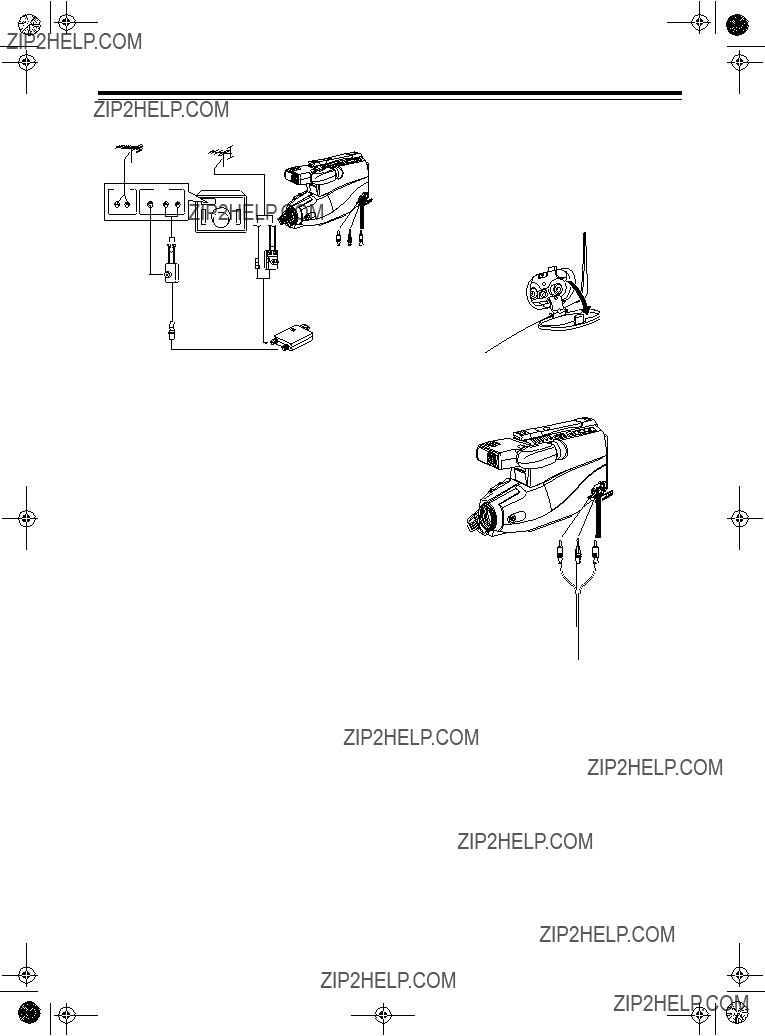
Standard TV
To connect the camcorder to a standard TV (with only VHF and UHF terminals), you need an RF adapter kit (CMC No.
???RF converter
???
???
Cautions:
???Use only the recommended RF adapter kit with this camcorder. You can order the kit from your local Radio Shack store.
???The RF converter is a sealed unit. Do not attempt to open or modify it.
???Do not damage or drop the RF converter or subject it to mechanical vibration.
???Unplug the RF converter during lightning storms.
Notes:
???You do not have to disconnect the RF con- verter when you watch TV broadcasts. Sim- ply set the TV???s tuner as usual.
???Unless your antenna is
1.Use a fingernail to pull down the cover on the camcorder???s AUDIO/VIDEO OUT/IN jack compartment to open it.
Caution: The cover on the AUDIO/VIDEO OUT/IN jack compartment is attached to the camcorder. Do not try to remove it.
2.Connect the RF converter???s plug to the camcorder???s VIDEO, RF DC OUT, and AUDIO jacks.
3.Set AV OUT/IN inside the AUDIO/VIDEO OUT/IN jack compartment to OUT.
4.Disconnect the VHF antenna/cable wire from your TV and connect it to the RF con- verter???s IN FROM ANT jack:
???If the antenna/cable wire is the round,
???If the antenna/cable wire is the flat, 300- ohm type, use another 300- to
33
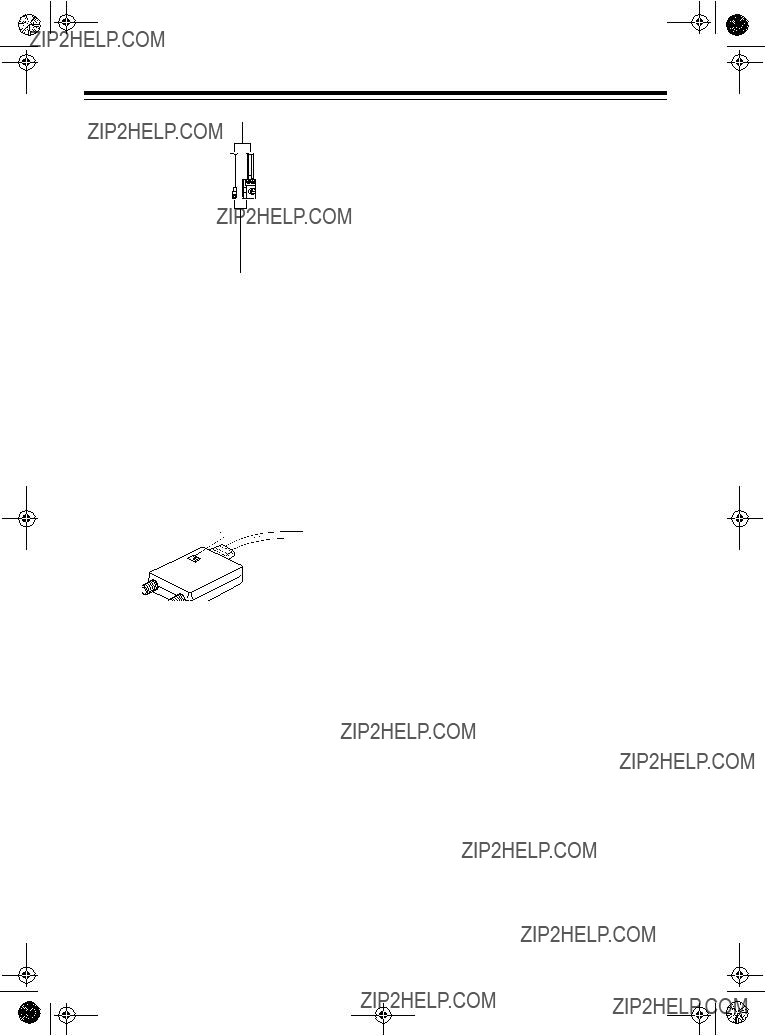
5.Using the supplied
???If the TV???s VHF antenna terminal is the round,
???If the TV???s VHF antenna terminal is the flat,
6.Set CHANNEL on the RF converter to 3 or 4.
CHANNEL
PLAYBACK
After you connect the camcorder to your TV, fol- low these steps to play a tape.
1.Turn on the TV, then:
???If you are using a TV with audio/video (A/V) jacks, set it to the video mode.
???If you are using a standard TV, set the TV???s tuner to the same channel where you set CHANNEL on the RF converter (3 or 4).
2.Slide POWER on the camcorder to VCR.
3.Insert a cassette into the camcorder.
4.Press PLAY on the camcorder. The tape plays on your TV.
5.Press STOP/EJECT to stop playback. Press STOP/EJECT again to remove the cassette.
34

ADDITIONAL INFORMATION
TROUBLESHOOTING
If you follow the instructions in this manual and still have trouble operating your camcorder, refer to the following troubleshooting chart. If you still cannot solve the problem, take your camcorder to your local Radio Shack store for assistance.
35
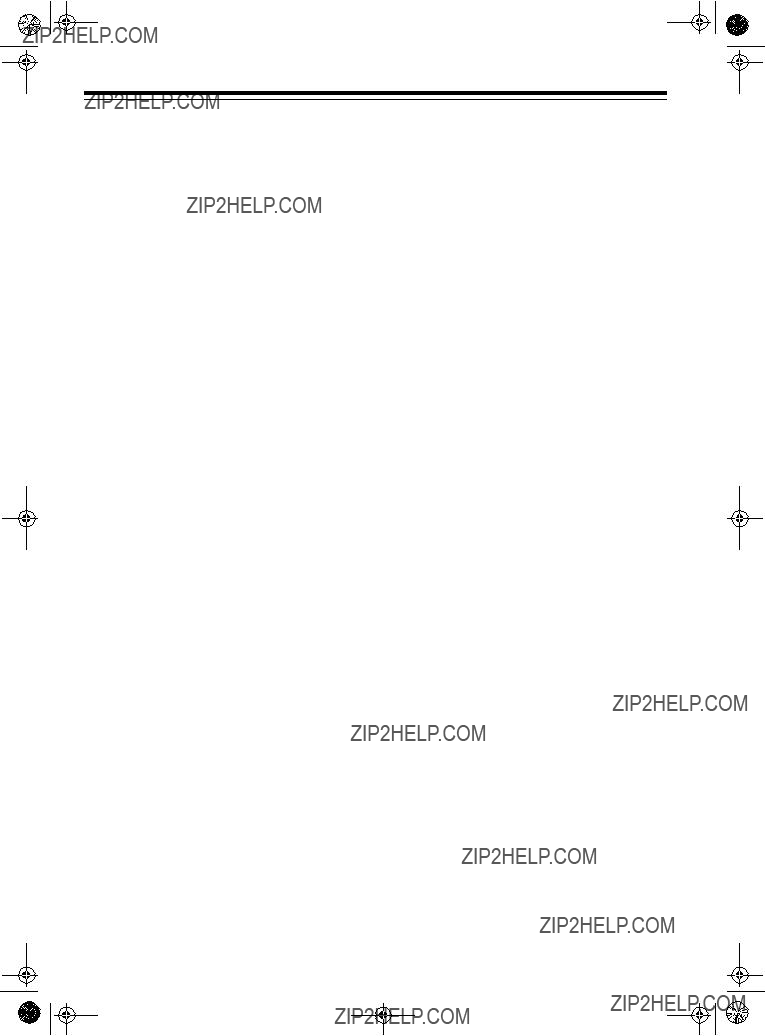
36

37

CARE AND MAINTENANCE
Your Optimus Model 130 MovieCorder cam- corder is an example of superior design and craftsmanship. The following suggestions will help you care for the camcorder so you can en- joy it for years.
Keep the camcorder dry. If it gets wet, wipe it dry immediately. Liq- uids can contain minerals that corrode electronic circuits.
Use and store the camcorder only in normal temperature envi- ronments. Temperature ex- tremes can shorten the life of electronic devices, damage bat- teries, and distort or melt plastic parts.
Handle the camcorder gently and carefully. Dropping it can dam- age circuit boards and cases, and cause it to work improperly.
Keep the camcorder away from dust and dirt, which can cause premature wear of parts.
Wipe the camcorder with a damp cloth occasionally to keep it look- ing new. Do not use harsh chem- icals, cleaning solvents, or strong detergents to clean it.
Modifying or tampering with the camcorder???s in- ternal components can cause a malfunction and might invalidate its warranty and void your FCC authorization to operate it. If your camcorder is not performing as it should, take it to your local Radio Shack store for assistance.
HANDLING
???Remove the cassette tape and turn off the power when the camcorder is not in use.
???Avoid shocks and drops. Do not drop or otherwise subject the camcorder to hard shocks or strong vibrations. Bumping or striking the unit during recording generates noise in the recorded image.
???To protect the lens, always replace the lens cap when the camcorder is not in use. Do not touch the lens surface with your hand.
???Do not point the camcorder lens or the viewfinder eyepiece at the sun, whether recording is in progress or not. Direct sun- light can make recording impossible, burn the CCD imager, and damage the cam- corder beyond repair. Be particularly care- ful when recording outside.
???Do not use the camcorder in excessive temperatures and humidity. You can use the camcorder between 32?? F and 104?? F and between 35% and 80% relative humid- ity.
???Do not store the unit in an unventilated car in the summer, in direct sunlight, or near strong heat sources. This can result in severe damage to the camcorder???s case and electronic circuits.
???Avoid magnetic sources. Using the cam- corder near strong fluorescent lights, motors, televisions, or other magnetic sources can adversely affect recorded images.
???Avoid situations where water, sand, dust or other foreign matter could get on or inside the camcorder. Such substances could cause malfunctions.
???Do not use or leave the camcorder in areas with excessive smoke, steam, dust, or moisture. Such environments can cause dew to form on the camcorder???s lenses. Be sure to provide ample ventilation.
38

???Do not use the camcorder on its side. The tape might not wind properly and might jam.
???Some small, portable tripods might be diffi- cult to connect and might not be sturdy enough to support your camcorder. Be sure to use only a strong, stable tripod.
SERVICING YOUR
CAMCORDER
Except as noted in this owner???s manual, there are no
???To clean the camcorder???s lens and optical elements, use air blowers and lens papers designed for photographic lenses.
???To clean the picture tube face and lens inside the eyepiece, press and hold down the cover???s tab on the back of the eyepiece, then open the cover.
though the audio signal is clear. Head cleaning must be done by an experienced camcorder technician. If the camcorder???s heads become dirty, contact your local Radio Shack store for assistance.
ERASE PROTECTION
Video cassettes have an
If you try to record on a tape with the
If you want to record on a video cassette that has had its tab removed, put a piece of heavy plastic tape over the
Caution: The eyepiece???s cover is not remov- able. Do not try to remove it from the eyepiece.
Clean the picture tube face and lens using a soft
CLEANING THE VIDEO HEADS
The camcorder???s video heads require cleaning from time to time. Dirty video heads can cause the playback picture to become blurred even
STORING YOUR VIDEO
CASSETTES
Eject and store the cassette when you finish us- ing it. This helps protect the cassette and the camcorder???s internal mechanisms from dust.
Place your video cassettes in their protective boxes and store them in a cool, dry,
Note: Tape can become wound too tightly around the cassette???s spools after numerous re- cordings and playbacks. This can cause the cassette to improperly load when you insert it.
39

On most cassettes there is a

THE FCC WANTS YOU TO
KNOW
This device complies with Part 15 of FCC Rules. Operation is subject to the following two condi- tions: (1) This device may not cause harmful in- terference, and (2) this device must accept any interference received, including interference that may cause undesired operation.
This equipment complies with the limits for a Class B digital device as specified in Part 15 of FCC Rules. These limits provide reasonable protection against radio and TV interference in a residential area. However, your equipment might cause TV or radio interference even when it is operating properly. To eliminate interfer- ence, you can try one or more of the following corrective measures:
???Reorient or relocate the receiving antenna
???Increase the distance between the equip- ment and the radio or TV
???Use outlets on different electrical circuits for the equipment and the radio or TV
Consult your local Radio Shack store if the prob- lem still exists.
You must use shielded interface cables with this equipment.
Modifying or tampering with the camcorder???s in- ternal components can cause a malfunction and might invalidate the camcorder???s warranty and void your FCC authorization to operate it. If your camcorder is not performing as it should, take it to your local Radio Shack Store for assistance.
40

SPECIFICATIONS
Specifications are typical; individual units might vary. Specifications are subject to change and im- provement without notice.
41

NOTES
42

43

RADIO SHACK LIMITED WARRANTY
This product is warranted against defects for 90 days from date of pur- chase from Radio Shack
EXCEPT AS PROVIDED HEREIN, RADIO SHACK MAKES NO
EXPRESS WARRANTIES AND ANY IMPLIED WARRANTIES ARE LIM-
ITED IN DURATION TO THE DURATION OF THE WRITTEN LIMITED WARRANTIES CONTAINED HEREIN. Some states do not permit limita- tion or exclusion of implied warranties; therefore, the aforesaid limita- tion(s) or exclusion(s) may not apply to the purchaser.
This warranty gives you specific legal rights and you may also have other rights which vary from state to state.
RADIO SHACK
A Division of Tandy Corporation
Fort Worth, Texas 76102